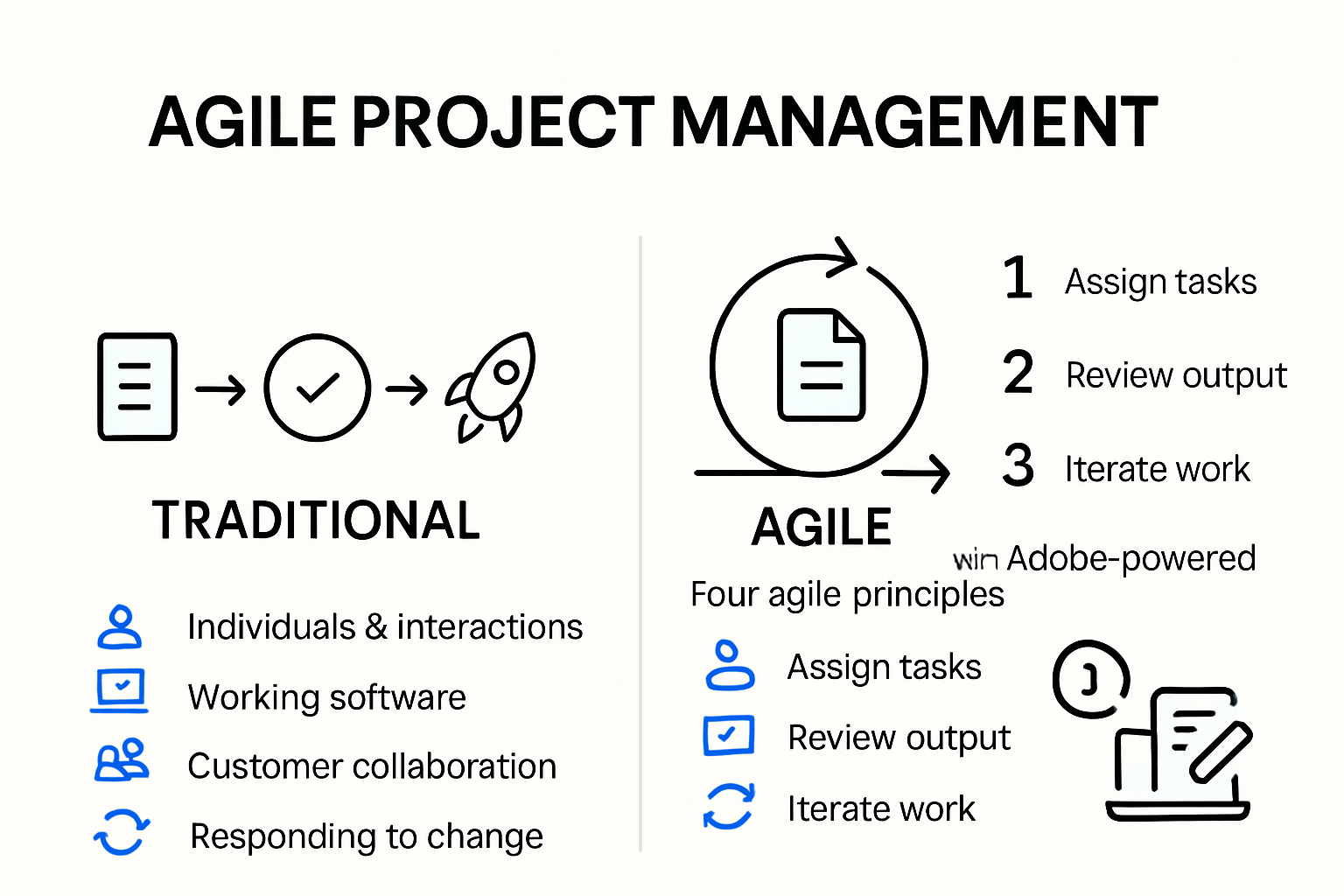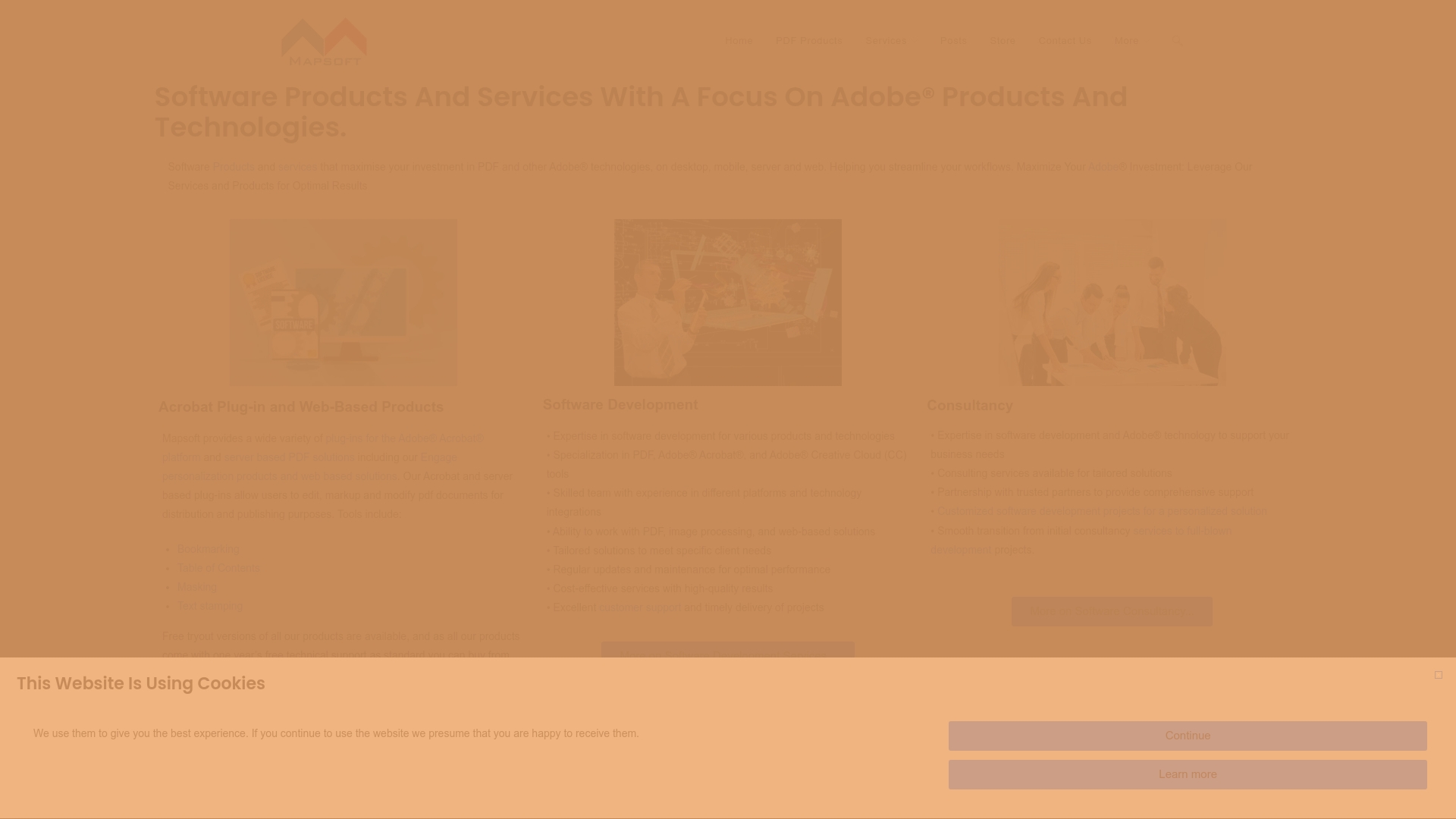Agile project management is shaping the way Adobe-powered businesses handle creative and document workflows today. Nearly 71 percent of companies now use Agile to drive faster innovation and boost team collaboration. This sounds like a perfect recipe for chaos, right? The surprising part is that Agile works best when businesses ditch the rigid rules and focus on flexible teamwork and rapid feedback. If you think project management still means endless meetings and Gantt charts, get ready for a whole new playbook.
Table of Contents
- Understanding Agile Project Management Principles
- Benefits of Agile for IT and Document Workflows
- Implementing Agile with Adobe Solutions
- Best Practices for Enterprise PDF Success
Quick Summary
| Takeaway | Explanation |
|---|---|
| Adopt Agile for Flexibility | Implement Agile methodologies to quickly adapt to changes in requirements and technology. |
| Promote Team Collaboration | Enhance productivity through transparent communication and cross-functional teamwork in projects. |
| Utilize Adobe Tools for Agile | Leverage Adobe’s tools like Creative Cloud for seamless integration of Agile practices. |
| Implement Structured PDF Workflows | Create systematic yet flexible workflows for effective PDF document management with clear processes. |
| Focus on Continuous Improvement | Encourage regular retrospectives to learn and enhance team performance continuously. |
Understanding Agile Project Management Principles
Agile project management represents a transformative approach to delivering projects with unprecedented flexibility and customer-centric precision. At its core, this methodology fundamentally shifts how businesses manage complex workflows, particularly in technology-driven environments like Adobe-powered ecosystems.
The Core Philosophy of Agile Methodology
Agile project management emerged as a revolutionary response to traditional rigid project management frameworks. According to research from the National Institutes of Health, the methodology prioritizes adaptability, continuous improvement, and collaborative processes over strict, linear planning. Unlike conventional methods that treat project development as a sequential process, agile breaks projects into smaller, manageable iterations called sprints.
The fundamental principles revolve around four key pillars: individuals and interactions over processes and tools, working software over comprehensive documentation, customer collaboration over contract negotiation, and responding to change over following a predefined plan. These principles enable teams to pivot quickly, incorporate feedback rapidly, and deliver value more consistently.
To help you quickly distinguish between traditional and Agile project management in Adobe-powered environments, here’s a comparison table summarizing their core differences based on principles discussed above:
| Aspect | Traditional Project Management | Agile Project Management |
|---|---|---|
| Approach | Sequential, rigid planning | Iterative, flexible sprints |
| Feedback | Limited, at set milestones | Continuous, throughout all phases |
| Team Structure | Departmental silos | Cross-functional, collaborative |
| Adaptability | Low (resistant to changes) | High (rapid response to change) |
| Documentation | Extensive, up-front | Focus on working software/results |
| Customer Involvement | Mainly at beginning and end | Ongoing, regular reviews |
| Example Adobe Application | Waterfall asset creation | Incremental creative workflows |

Implementing Agile in Technology Workflows
For Adobe-powered businesses, agile project management becomes particularly potent when applied to software development, digital asset management, and creative workflows. Teams can leverage iterative approaches to continuously refine digital products, optimize document processes, and enhance collaborative capabilities.
Key implementation strategies include:
- Iterative Development: Breaking complex projects into short, focused work cycles
- Continuous Feedback: Regular stakeholder reviews and rapid adaptation
- Cross Functional Collaboration: Integrated teams working seamlessly across departments
The methodology requires a cultural shift, demanding teams embrace transparency, frequent communication, and a willingness to adapt. Research indicates that organizations implementing agile practices see significant improvements in project predictability, team productivity, and overall customer satisfaction.
For businesses using Adobe technologies, agile project management offers a strategic framework to maximize digital asset creation, document workflow optimization, and collaborative project execution. By adopting these principles, organizations can transform how they approach complex digital initiatives, ensuring more responsive, efficient, and customer-aligned outcomes.
Read more about advanced digital project strategies that complement agile methodologies in technology-driven environments.
Benefits of Agile for IT and Document Workflows
Agile project management revolutionizes how businesses handle complex IT and document workflows, offering transformative advantages that go far beyond traditional project management approaches. For organizations leveraging Adobe technologies, these benefits become particularly pronounced in digital asset management and collaborative environments.
Enhanced Flexibility and Rapid Adaptation
According to Wake Forest University’s School of Professional Studies, Agile methodologies provide unprecedented flexibility in project execution. This approach allows teams to quickly respond to changing requirements, technological shifts, and emerging client needs. In document workflow contexts, this means teams can rapidly adjust document processing strategies, incorporate feedback, and modify digital asset management protocols without extensive restructuring.
The U.S. Government Accountability Office highlights that Agile development can significantly reduce project risks by enabling quicker deliveries and more responsive project management. For Adobe-powered businesses, this translates into more dynamic document handling, faster iteration of creative projects, and more efficient collaborative workflows.
Improved Team Collaboration and Productivity
Key collaborative advantages include:
- Transparent Communication: Real-time progress tracking and open feedback mechanisms
- Incremental Development: Breaking complex projects into manageable, measurable units
- Continuous Improvement: Regular retrospectives that enhance team performance
A comprehensive study exploring Agile Project Management in IT emphasizes that successful implementation requires robust team dynamics and a culture of continuous learning. For businesses using Adobe solutions, this means creating cross-functional teams capable of seamlessly integrating document creation, editing, and management processes.
Quantifiable Business Benefits
Agile methodologies deliver measurable improvements in project outcomes. Teams adopting Agile approaches typically experience enhanced customer satisfaction, higher quality deliverables, and more predictable project timelines. In document workflow scenarios, this could mean faster PDF processing, more efficient creative asset management, and streamlined collaborative editing processes.
Learn more about optimizing team collaboration with Adobe solutions and discover how Agile principles can transform your digital workflows. By embracing these methodologies, organizations can create more responsive, efficient, and innovative project management strategies that leverage the full potential of Adobe technologies.
Implementing Agile with Adobe Solutions
Implementing Agile methodologies within Adobe-powered environments requires a strategic approach that combines technological capabilities with adaptive project management principles. Organizations can transform their workflow efficiency by leveraging Adobe’s robust suite of tools and integrating Agile practices systematically.
Agile Frameworks and Adobe Ecosystem Integration
Research from project management experts demonstrates that successful Agile implementation involves carefully selecting frameworks that align with organizational goals. For Adobe-powered businesses, this means adopting methodologies like Scrum or Kanban that complement digital asset management and creative workflows.
Specifically, Adobe Creative Cloud and Document Cloud offer native features that support Agile principles. Teams can utilize tools like shared libraries, version control, and collaborative editing to create iterative workflows that reflect Agile’s core values of rapid iteration and continuous improvement.
Practical Implementation Strategies
Key implementation approaches include:
- Incremental Asset Development: Breaking creative projects into smaller, manageable sprints
- Real-time Collaboration: Utilizing Adobe’s cloud-based sharing and commenting features
- Workflow Automation: Integrating Adobe tools with project management platforms
According to research examining government software teams, successful Agile adoption requires continuous user involvement and flexible development processes. In the Adobe ecosystem, this translates to creating dynamic workflows that allow rapid prototyping, immediate feedback, and quick pivots.
Technology and Team Alignment
Effective Agile implementation goes beyond tool selection. A comprehensive study on Agile Project Management emphasizes the critical role of team culture and continuous learning. Organizations must invest in training, promote cross-functional collaboration, and develop a mindset that values adaptability and incremental progress.
Adobe solutions provide powerful platforms for this transformation. Creative teams can use tools like Adobe XD for rapid prototyping, while document management professionals can leverage Adobe Acrobat’s collaborative features to streamline review and approval processes.
Discover advanced collaboration strategies for Adobe-powered teams that can help organizations maximize their Agile potential. By combining technological capabilities with adaptive methodologies, businesses can create more responsive, efficient, and innovative project management approaches.
Best Practices for Enterprise PDF Success
Enterprise PDF management represents a critical intersection of technological efficiency and strategic document handling. For organizations leveraging Adobe technologies, implementing best practices can dramatically transform document workflows, enhance collaboration, and optimize operational productivity.
Strategic PDF Workflow Design
Research exploring comprehensive project management practices emphasizes the importance of creating structured yet flexible document management strategies. Successful enterprise PDF workflows require a systematic approach that balances standardization with adaptability.
Key considerations include establishing clear document naming conventions, implementing robust version control mechanisms, and developing standardized processes for PDF creation, editing, and archiving. This approach ensures consistency across different departments while maintaining the agility needed to respond to changing business requirements.
Here is a summary table outlining key best practices for enterprise PDF workflow success along with their main focus areas, as described in the best practices section:
| Best Practice | Focus Area |
|---|---|
| Clear Naming Conventions | Consistency & Organization |
| Robust Version Control | Change Management & Tracking |
| Standardized Creation Processes | Efficiency & Repeatability |
| Automated Metadata Management | Searchability & Intelligent Tagging |
| Secure Document Workflows | Access Control & Protection |
| Seamless Format Conversion | Interoperability & Scalability |
| API Integrations | Technological Flexibility & Automation |
| Batch Processing & OCR | Performance & Document Recognition |
Advanced PDF Management Techniques
Critical techniques for enterprise PDF success include:
- Automated Metadata Management: Implementing intelligent tagging and categorization systems
- Secure Document Workflows: Developing multi-level access and authentication protocols
- Intelligent Conversion Processes: Creating seamless transitions between different file formats
A comprehensive research compilation highlights 38 specific practices that organizations can adapt to improve their PDF management strategies. These practices range from technical implementation to process optimization, providing a holistic approach to enterprise document handling.
Technological Integration and Scalability
Successful PDF management goes beyond individual tools and requires a comprehensive technological ecosystem. Enterprises must focus on creating interoperable systems that allow smooth document processing across different platforms and applications. This involves selecting Adobe solutions that offer robust API integrations, support for multiple file formats, and scalable infrastructure.
The key is developing a flexible framework that can accommodate growing business needs while maintaining high standards of document security, accessibility, and performance. This means investing in solutions that offer advanced features like OCR, batch processing, and intelligent document recognition.
Explore our comprehensive bulk PDF conversion solutions that can transform how your organization handles complex document workflows. By implementing these best practices, businesses can create more efficient, secure, and adaptable PDF management strategies that drive operational excellence.

Frequently Asked Questions
What is Agile project management?
Agile project management is a flexible approach to project execution that emphasizes continuous improvement, iterative development, and collaborative teamwork. It allows businesses to quickly adapt to changing requirements and focus on customer collaboration.
How can Adobe tools be integrated into Agile workflows?
Adobe tools like Creative Cloud and Document Cloud support Agile methodologies by enabling real-time collaboration, version control, and shared libraries. These features help teams maintain iterative workflows and enhance productivity through seamless integration.
What are the key benefits of implementing Agile in document workflows?
Implementing Agile in document workflows enhances flexibility, allows for rapid adaptation to changes, improves team collaboration, and provides quantifiable business benefits such as faster document processing and higher quality deliverables.
How does Agile project management differ from traditional project management?
Agile project management emphasizes iterative processes and flexibility, allowing teams to adapt quickly, whereas traditional project management follows a linear and sequential approach with limited room for changes once the project is underway.
Accelerate Agile Success with Purpose-Built Adobe Solutions
Is your team struggling to keep creative projects agile while managing an avalanche of PDFs and document workflows? The article reveals how flexibility, rapid adaptation, and smooth collaboration are the heart of Agile project management for Adobe-powered businesses. But even with the right mindset, many organizations hit roadblocks when scattered tools slow down innovation and workflows turn clunky under pressure.

Imagine eliminating bottlenecks by integrating specialized PDF automation tools and custom plug-ins designed for Adobe environments. At Mapsoft.com, we help businesses like yours bridge the gap between Agile theory and everyday results. Set up smarter document workflows, automate repetitive PDF tasks, or craft tailored solutions that unlock the full potential of your Adobe investment. Ready to turn agile principles into measurable productivity? Explore our workflow automation options and see how true enterprise efficiency feels. Start your transformation today—competition is not waiting, so why should you?



